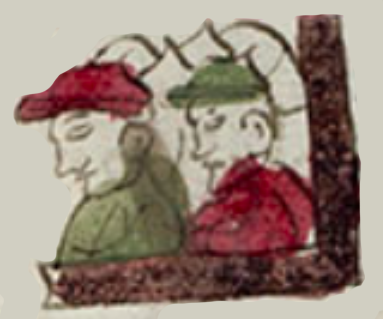pipiltin (CST28)
This painting of the simplex glyph for nobles (pipiltin, plural of pilli) doubles as the glyph for tlatoque (plural of tlatoani), rulers. The glyph shows two men in profile, facing toward the viewer’s left. Both wear caps or hats and shirts or jackets. One has a red hat and a green shirt, and the other has a green hat and a red shirt. Only their heads and upper bodies show. The two men are inside a dark brown reverse L-shape. A black-line drawing behind their heads is not easily discerned. Presumably, one man is a tlatoani (perhaps the first one) and the other is a pilli (perhaps the one behind the tlatoani).
Stephanie Wood
For more on the Codex Sierra, see Kevin Terraciano’s study (2021).
Stephanie Wood
1550–1564
Jeff Haskett-Wood
tlahtoani, tlahtoque, nobles, gobernantes, jerarquía social, gobierno, hombres, textiles

pil(li), a man of noble lineage, https://nahuatl.wired-humanities.org/content/pilli
pipiltin, men of noble lineage, https://nahuatl.wired-humanities.org/content/pipiltin
nobles
Stephanie Wood
Códice Sierra-Texupan, plate 28, page dated 1559. Origin: Santa Catalina Texupan, Mixteca Alta, State of Oaxaca. Kevin Terraciano has published an outstanding study of this manuscript (Codex Sierra, 2021), and in his book he refers to alphabetic and “pictorial” writing, not hieroglyphic writing. We are still counting some of the imagery from this source as hieroglyphic writing, but we are also including examples of “iconography” where the images verge on European style illustrations or scenes showing activities. We have this iconography category so that such images can be fruitfully compared with hieroglyphs. Hieroglyphic writing was evolving as a result of the influence of European illustrations, and even alphabetic writing impacted it.
https://bidilaf.buap.mx/objeto.xql?id=48281&busqueda=Texupan&action=search
The Biblioteca Digital Lafragua of the Biblioteca Histórica José María Lafragua in Puebla, Mexico, publishes this Códice Sierra-Texupan, 1550–1564 (62pp., 30.7 x 21.8 cm.), referring to it as being in the “Public Domain.” This image is published here under a Creative Commons license, asking that you cite the Biblioteca Digital Lafragua and this Visual Lexicon of Aztec Hieroglyphs.



